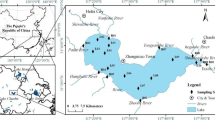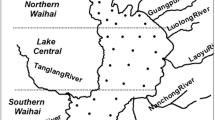Abstract
Impact of anthropogenic loading of phosphorous (P) to an aquatic ecosystem can be qualitatively assessed by measuring the buildup and distribution of P in sediments and by differentiating bioavailable and recalcitrant P pools. Distribution of P pools in sediments is affected by the physico-chemical properties including specific elements, particle size distribution, pH, electrical conductivity (EC), and carbonate content. We applied X-ray fluorescence and scanning electron microscopy (SEM) methods to characterize sediments from western rivers in the Urmia Lake basin in Iran with a particular focus on properties that are relevant to P speciation. Phosphorous pools were sequentially extracted into operationally defined exchangeable (EXCH-P), iron and aluminum oxide-bound (Fe/Al-P), calcium-bound (Ca-P), and residual (RES-P) P pools. In river sediments, the size of P pool was found to be in the order of Ca-P > RES-P > Fe/Al-P > EXCH-P indicating small fraction of bioavailable P pool and Ca-P minerals being the most dominant P sink. Carbonate-related properties had an inverse relationship with bioavailable P pools in the river sediments studied. The principal component analysis (PCA) of the sequential extraction data with sediment properties revealed that four principal components described 82.7% of total variation. Similarly, particle size-related properties were found to have the highest eigenvalues in the first PC. Electron diffraction spectra (EDS) and X-ray fluorescence (XRF) analyses showed a largely uniform distribution of P in the upstream sediment. However, limited evidence of local enrichment of P with Fe, Al, and Ca contents was observed in the downstream river sediments. Correlation of Fe/Al-P pool size with Al2O3 and SiO2 contents indicated that P was associated with Al oxide and clay minerals in the sediment matrix. Overall, the results from this study provide insights into the variability of upstream and downstream river processes and their relationship with P pools with regard to their bioavailability. These results are expected to be useful in assessing the potential impact of P loading on the aquatic ecosystem in the Urmia Lake basin.







Similar content being viewed by others
References
Aldridge KT, Brookes JD, Ganf GG (2010) Changes in abiotic and biotic phosphorous uptake across a gradient of stream condition. River Res Appl 26:636–649
Alipour S (2006) Hydrogeochemistry of seasonal variation of Urmia salt lake, Iran. Saline Syst 2:9–16
Bowman RA, Olsen SR, Watanabe FS (1978) Greenhouse evaluation of residual phosphate by four phosphorous methods in neutral and calcareous soils. Soil Sci Soc Am J 42:451–454
Chang SC, Jackson ML (1957) Fractionation of soil phosphorus. Soil Sci 84:133–144
Cordell D, Drangert JO, White S (2009) The story of phosphorus: global food security and food for thought. Glob Environ Chang 19:292–305
Dao TH, Miao YX, Zhang FS (2011) X-ray fluorescence spectrometry-based approach to precision management of bioavailable phosphorus in soil environments. J Soils Sediments 11:577–588
Delju AH, Ceylan A, Piguet E, Rebetez M (2013) Observed climate variability and change in Urmia Lake Basin, Iran. Theor Appl Climatol 111:285–296
Diaz OA, Daroub SH, Stuk JD, Clark MW, Lang TA, Reddy K (2006) Sediment inventory and phosphorous fractions for water conservation Area canals in Everglades. Soil Sci Soc Am J 70:868–871
Eimanifar A, Mohebbi F (2007) Urmia Lake (Northwest Iran): a brief review. Saline Syst 3:5–8
Elliott JC (1994) Structure and chemistry of the apatite and other calcium orthophosphates. Elsevier Science, Amsterdam
Elser J, Bennett E (2011) Phosphorous cycle: a broken biogeochemical cycle. Nature 478:29–31
Hartzell JL, Jordan TE, Cornwell JC (2010) Phosphorus burial in sediments along the salinity gradient of the Patuxent River, a subestuary of the Chesapeake Bay (USA). Estuar Coasts 33:92–106
He H, Yu Z, Yao Q, Chen H, Mi T (2010) The hydrological regime and particulate size control phosphorous form in the suspended solid fraction in the dammed Huanghe (Yellow River). Hydrobiologia 638:203–211
He Z, Senwo ZN, Tazisong IA (2012) Long-term dynamics of labile and stable phosphorous following poultry litter application to pasture soils. Commun Soil Sci Plant Anal 43:2835–2850
Hedley MJ, Stewart JWB, Chauhan B (1982) Changes in inorganic and organic soil phosphorus fractions induced by cultivation practices and by laboratory incubations. Soil Sci Soc Am J 46:970–976
Hoffman AR, Armstrong DE, Lathrop RC, Penn MR (2009) Characteristics and influence of phosphorus accumulated in the bed sediments of a stream located in an agricultural watershed. Aquat Geochem 15:371–389
Hopkinson CS, Wetzel RL (1982) In situ measurements of nutrient and oxygen fluxes in a coastal marine benthic community. Mar Ecol Prog Ser 10:29–35
Jalali M (2010) Phosphorous fractionation in river sediments, Hamadan, western Iran. Soil Sediment Contam 19:560–572
Jordan TE, Cornwell JC, Boynton WR, Anderson JT (2008) Changes in phosphorus biogeochemistry along an estuarine salinity gradient: The iron conveyer belt. Limnol Oceanogr 53:172–184
Joshi SR, Kukkadapu R, Burdige D, Bowden M, Sparks DL, Jaisi DP (2015) Organic matter remineralization predominates phosphorous cycling in the mid-bay sediments in the Chesapeake Bay. Environ Sci Technol 49:5887–5896
Joshi SR, Li X, Jaisi DP (2016) Transformation of phosphorous pools in an agricultural soil: an application of oxygen-18 labeling in phosphate. Soil Sci Soc Am J 80:69–78
Kelts K, Shahrabi M (1986) Holocene sedimentology of hypersaline Lake Urmia, northwestern Iran. Paleogeogr Paleoclimatol Paleoecol 54:105–130
Kerr JG, Burford M, Olley J, Udy J (2011) Nitrogen and phosphorus storage in contrasting reaches of a sub-tropical river system. Water Air Soil Pollut 217:523–534
Kou S (1996) Phosphorus. In: Sparks DL, Page AL, Helmke PA, Loeppert PN, Tabatabai MA, Johnston CT, Summers ME (eds) Methods of soil analysis. Part 3. Chemical Methods. SSSA, NO.5, Madison, pp 437–474
Kruse J, Abraham M, Amelung W, Baum C, Bol R, Kühn O, Lewandowski H, Niederberger J, Oelmann Y, Rüger C, Santner J (2015) Innovative methods in soil phosphorus research: a review. J Plant Nutr Soil Sci 178:43–88
Lehmann J, Lan Z, Hyland C, Sato S, Solomon D, Ketterings QM (2005) Long-term dynamics of phosphorus forms and retention in manure-amended soils. Environ Sci Technol 39:6672–6680
Li W, Joshi SR, Hou G, Burdige DJ, Sparks DL, Jaisi DP (2015) Characterizing phosphorous speciation of Chesapeake Bay sediments using chemical extraction, 31P NMR, and X-ray absorption fine structure spectroscopy. Environ Sci Technol 49:203–211
Liu CW, Lin KH, Kuo YM (2003) Application of factor analysis in the assessment of groundwater quality in a blackfoot disease area in Taiwan. Sci Total Environ 313:77–89
Liu SM, Zhang J, Li DJ (2004) Phosphorous cycling in sediments of the Bohai and Yellow Seas. Estuar Coast Shelf Sci 59:209–218
Loeppert RH, Suarez DL (1996) Carbonate and gypsum. In: Sparks DL, Page AL, Helmke PA, Loeppert PN, Tabatabai MA, Johnston CT, Summers ME(eds) Methods of soil analysis. Part 3. Chemical Methods. SSSA, NO.5, Madison, pp 437–474
Murphy J, Riley JP (1962) A modified single solution method for the determination phosphate in natural waters. Anal Chim Acta 27:31–36
Olsen SR, Sommers LE (1982) Phosphorous. In: Page AL, Miller RH (eds) Methods of soil analysis, 2nd. Agronomy monograph 9 Vol. Part 2 ASA and SSSA, Madison, pp 403–430
Oxmann JF, Pham QH, Lara RJ (2008) Quantification of individual phosphorous species in sediment: a sequential conversion and extraction method. Eur J Soil Sci 59:1177–1190
Pacini N, Gächter R (1999) Speciation of riverine particulate phosphorous during rain events. Biogeochemistry 47:87–109
Powers SM, Johnson RA, Stanley EH (2012) Nutrient retention and the problem of hydrologic disconnection in streams and wetlands. Ecosystems 15:435–449
Reddy KR, Diaz OA, Scinto LJ, Agami M (1995) Phosphorous dynamics in selected wetlands and streams of the Lake Okeechobee Basin. Ecol Eng 5:183–207
Rivard C, Lanson B, Cotte M (2016) Phosphorous speciation and micro-scale spatial distribution in North-American temperate agricultural soils from micro X-ray fluorescence and X-ray absorption near-edge spectroscopy. Plant Soil 401:7–22
Rowell DL (1994) Soil science: methods and applications. Longman Group, Harlo
Ruttenberg C (1992) Development of a sequential extraction for different forms of phosphorus in marine sediments. Limnol Oceanogr 37:1460–1482
Samadi A, Gilkes RJ (1999) Phosphorous transformations and their relationships with calcareous soil properties of southern Western Australia. Soil Sci Soc Am J 62:809–815
Schönbrunner IM, Preiner S, Hein T (2012) Impact of drying and re-flooding of sediment on phosphorus dynamics of river-floodplain systems. Sci Total Environ 432:329–337
Shaheen SM, Tsadilas CD, Stamatiadis S (2007) Inorganic phosphorous forms in some Entisols and Aridisols of Egypt. Geoderma 142:217–225
Sharpley A, Jarvie HP, Buda A, May L, Spears B, Kleinman P (2013) Phosphorous legacy: overcoming the effects of past management practices to mitigate future water quality impairment. J Environ Qual 42:1308–1326
Shelton JE, Coleman NT (1968) Inorganic phosphorous fractions and their relationship to residual value of large applications of phosphorous on high phosphorous fixing soils. Soil Sci Soc Am J 32:91–94
Suh S, Yee S (2011) Phosphorous use-efficiency of agriculture and food system in the US. Chemosphere 84:806–813
Tiessen H, Stewart JWB, Moir JO (1983) Changes in organic and inorganic phosphorous composition of two grassland soils and their particle size fractions during 60-90 years of cultivation. J Soil Sci 34:815–823
Tiessen HJWB, Stewart JWB, Cole CV (1984) Pathways of phosphorus transformations in soils of differing pedogenesis. Soil Sci Soc Am J 48:853–858
UNESCO (2012) UNESCO MAB Biosphere Reserves Directory (dated 24 January 24, 2012). Available at http://www.unesco.org/mabdb/br/brdir/directory/biores.asp?mode=gen&code=IRA+07
Upreti K, Joshi SR, McGrath J, Jaisi DP (2015) Factors controlling phosphorous mobilization in a Coastal Plain tributary to the Chesapeake Bay. Soil Sci Soc Am J 79:826–837
Van Cappellen P, Berner RA (1991) Fluorapatite crystal growth from modified seawater solutions. Geochim Cosmochim Acta 55:1219–1234
Van Stappen G, Fayazi G, Sorgeloos P (2001) International study on Artemia LXIII. Field study of the Artemia urmiana (Gunther, 1980) population in Lake Urmia, Iran. Hydrobiologia 466:133–143
Wang S, Jin X, Pang Y, Zhao H, Zhou X, Wu F (2005) Phosphorus fractions and phosphate sorption characteristics in relation to the sediment compositions of shallow lakes in the middle and lower reaches of Yangtze River region, China. J Colloid Interface Sci 289:339–346
Weigelhofer G, Fuchsberger J, Teufl B, Welti N, Hein T (2012) Effects of riparian forest buffers on in-stream nutrient retention in agricultural catchments. J Environ Qual 41:373–379
Wildman JRA, Hering JG (2011) Potential for release of sediment phosphorous to Lake Powell (Utah and Arizona) due to sediment resuspension during low water level. Lake Reserv Manag 27:365–375
Wright AL (2009) Soil phosphorous stocks and distribution in chemical fractions for long-term sugarcane, pasture, turfgrass, and forest systems in Florida. Nutr Cycl Agroecosyst 83:223–231
Yao QZ, Du JT, Chen HT, Yu ZG (2015) Particle-size distribution and phosphorus forms as a function of hydrological forcing in the Yellow River. Environ Sci Pollut Res 23:3385–3398
Zhang TQ, MacKenzie AF (1997) Changes of soil phosphorus fractions under long-term corn monoculture. Soil Sci Soc Am J 61:485–493
Zhang TQ, MacKenzie AF, Liang BC, Drury CF (2004) Soil test phosphorus and phosphorous fractions with long-term phosphorous addition and depletion. Soil Sci Soc Am J 68:519–528
Author information
Authors and Affiliations
Corresponding author
Additional information
Responsible editor: Boqiang Qin
Rights and permissions
About this article
Cite this article
Arfania, H., Samadi, A., Asadzadeh, F. et al. Distribution of phosphorous pools in western river sediments of the Urmia Lake basin, Iran. Environ Sci Pollut Res 25, 11614–11625 (2018). https://doi.org/10.1007/s11356-018-1191-3
Received:
Accepted:
Published:
Issue Date:
DOI: https://doi.org/10.1007/s11356-018-1191-3




